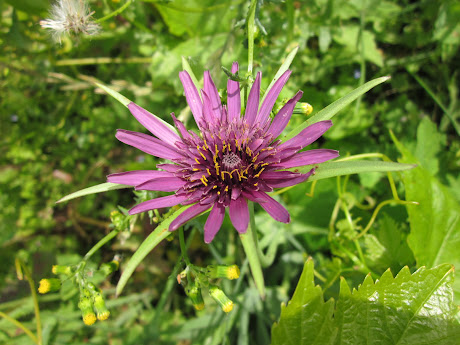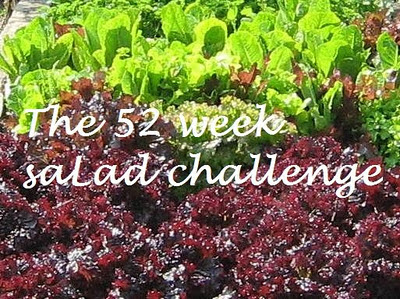Salad Days 2013: Propagated Peas
 |
| Peas ready for their propagator experiment. The left tray has the beets I told you about on Monday |
Last year I grew pea shoots for the first time. Lots of them. I found a small tray of thickly sown peas (either sourced from shop bought or the remains of a seed packet) were sufficient to form the 'base layer' with added sprouted seeds and microgreens to make a hearty salad for two.
I see from last year's notes it can take up to 6 weeks for the pea shoots to crop during the darkest months. Later sown crops steadily grow just that little bit faster week by week, until growing them takes around four weeks in March. I was therefore keen to explore if growth time could be speeded up in some way.
 |
| Experimental peas doing their stuff |
I had a bit of a 'light bulb' moment over the Christmas holidays and decided to press my new propagator into service to see if its protection would affect pea shoot growth in any way. I could use identical trays, with the same amount of growing media and peas added - 50 per tray and pre-soaked so they germinate more quickly. The trays could then sit side by side on my south facing bedroom windowsill with and without their lids. I left them sitting there quietly and had a look each morning with notebook in hand to see what was what.
Here are the results:
The lidded peas appeared a day earlier than the unlidded ones, on day 4 (7th January). Both trays of peas reached their maximum number of germinated seeds on the same day, day 10. Whilst the germination rate of the tray with a lid is higher, I don't think it's sufficiently high enough to be significant as both sets of peas had a relatively poor rate of germination (38% for the lidded peas and 30% for the unlidded). This is probably because the packet of seeds I was using up was right on its sow by date.
However, the better performance of the lidded peas has continued post germination. The lid was left on until some of the peas reached lid height on day 13 (15th January). I measured the height of the peas in each tray and found an average of 88 mm for the unlidded grown seeds and 105 mm for the lidded ones. This marked difference in growth has continued. On Tuesday this week (day 20) the peas' average heights were 104mm (unlidded) and 143mm (lidded).
 |
| Peas waving happily at the snow |
Therefore using a lidded propagator could be a useful way of bringing on windowsill grown pea shoots a little more quickly for no extra outlay, assuming you already have one. I'm saying could because I need to see if these results are repeatable rather than a one-off occurrence. It'll also be interesting to see if the observed difference in growth rates changes with increasing light.
I'm beginning to wonder if peas are a suitable small crop for this time of the year because their very nature is to be leggy, unlike their beet cousins grown alongside. These were looking a tad stretched before they succumbed to damping off. I'm also pondering whether the height of my bedroom windowsill is key to a successful early crop at this time of year. A comparison with a tray grown on my kitchen windowsill downstairs could be interesting. So, the experiments will continue :)
In a future post I'll be looking at another useful technique for producing earlier crops without needing a greenhouse or polytunnel to do so. It does however, require much more space than my windowsill...
How's your salad coming along? Either let me know in the comments, or leave a link to your salad filled blog post in Mr Linky below:











HI VP, that does look promising, I wonder if it could mean that a tray of mixed salad leaves might be ready to eat a couple of days before an uncovered equivalent too. I am planning to spend today - which is wet - setting up the conservatory for indoor growing, since I figured adding the plastic cover would give an extra layer of protection against the temperature drops, but it will still be a lot colder than your windowsill! Thanks for running the challenge again this year, it is good to be able to join in the fun.
ReplyDeleteSounds fascinating and I may have to experiment a bit with peas...I will link in in 2 weeks! May have our first salad from indoor growing of greens by then.
ReplyDeleteI found some packets of Franchi cut and come again lettuce seeds while I was clearing out the kitchen - does that count?
ReplyDeleteSeriously, I am not going to start anything until my kitchen is rebuilt, but I keep eyeing the lower bit of my lawn and wondering what it would like if I turned it into a mini potager, with raised beds. I think it would look pretty darned good...
Thanks for plotting the pea progress its really interesting. In a weaker moment this week, I was contemplating getting a few trays growing. I was thinking of starting some carrots in the unheated greenhouse with the help of some sheep fleece to keep them warm. (Well it works for the geraniums over winter) Anyhow the sudden drop in temp and forcast for gales and 10 inches of snow changed my mind. I will settle for reading the seed catalog instead. What a wuss!
ReplyDeleteMy first container of salad bowl lettuce, red mustard and lambs lettuce (early Jan) and two week old sowing of rocket are germinated and growing, but slowly and leggily. These were indoors in the porch. Peas sown in guttering in unheated greenhouse 13/1/13 have swelled but not germinated yet. Best thing at this time of year seems to be the mung beans sprouting in the airing cupboard - I reckon they will be by far and away the first eaters! Might go for another batch of them (or other sprout spouters) this week as they seem to be the most reliable this early in the year. Should also have picked the self-sown lambs lettuce from the garden before it snowed!!!
ReplyDeleteA lidded propagator can make a big difference on a wide range of plants in doors, not only by keeping the temperature up behind curtains but also by helping to keep the humidity levels up when central heating will be drying the air.
ReplyDeleteGreat Post VP!! This year, using more heat under the peas (summerhouse radiator), and putting them out under a grow light after germination, has made a big difference...speeding right along in fact. It's minus 12 c. degrees here in Nova Scotia Canada. It's nice to smell soil inside, when there is nothing but snow outside.
ReplyDeleteJust looked at your link to last year's post on seed sprouting - will try your tip of using the rinsing water for my bean sprouts to water my houseplants. As all the legume crops are good for adding nitrogen, I guess it could make some kind of sense that the rinsing water would have some useful stuff in it.
ReplyDeleteHello VP! So nice to see someone else sowing early indoors too!! Come on little peas! :) Hope they carry on well and I can't wait to hear about their progress!!
ReplyDeleteThanks for sharing the progress of your peas. I always enjoy carrying out little experiments like this too, but I'm not organised enough to make daily notes! Interesting to see what a difference a propagator lid can make, even at this time of year. I don't have a greenhouse, so I love reading about any alternative techniques for getting seedlings off to a good start - I look forward to your future posts on this subject.
ReplyDeleteNo pea shoots yet, but mung bean sprouts now wokked and eaten. Very fine too. I guess this means I can't buy any more salad now if I live up to my initial decree of no purchases after first crop. Tasted one of my rocket micro green seedlings today - was amazed by the strength of flavour in something so tiny. Great for sandwich sprinkles - will definitely be doing more of them.
ReplyDeleteA warm welcome to Sue, Ann Marie and The Tick Shop Gardener :)
ReplyDeleteJanet - it might be as much as a week earlier. The lidded shoots have continued to grow away more strongly
Donna - your link is always welcome :)
Victoria - of course they count. Looking forward to discussing your potager idea on Wednesday :)
Sue - on the whole wimping out was advisable. Monty Don warned against early sowing in The Guardian last week. On the whole he's right, but we've found in the 52 Week Salad Challenge that the rule can be bent slightly for some crops
Tuckshop Gardener - thanks for all your comments and posts. Glad you found the sprouting water tip useful and well done on your first harvest :)
Gaz - good point re central heating dryness. However, it looks like I went a little bit too far the other way!
Bren - I've been investigating grow lights since reading your post. Let's just say it's taken me into some unexpected 'shady' territory!
Anna - they're going to be eaten very soon :)
Ann Marie - it helps having the peas in the bedroom and always having a notebook to hand for when I wake up in the middle of the night with an overworking mind ;)
Oops - that should be The Tuckshop Gardener!
Delete